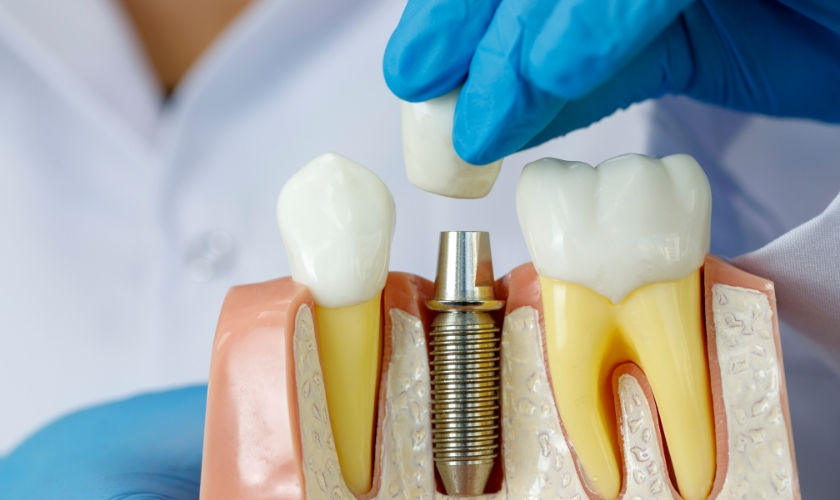Brushing Up on Brightness: A Guide to Safe and Effective Teeth Whitening
- Campbell Crossing Dentistry

- Apr 11, 2024
- 3 min read
A bright, white smile is often associated with confidence, health, and beauty. But over time, teeth can become stained by coffee, red wine, certain foods, and even simply by aging. If you're looking to restore your pearly whites and boost your smile's brilliance, then teeth whitening might be the answer.
This blog serves as your guide to safe and effective teeth whitening, exploring the different options available, their effectiveness, and tips for achieving a brighter smile without compromising your oral health.
Understanding Teeth Stains:
There are two main types of teeth stains:
Extrinsic stains: These surface stains affect the outer layer of enamel and are caused by consuming stained foods and beverages like coffee, tea, red wine, and dark berries. Smoking and tobacco use can also contribute to extrinsic stains.
Intrinsic stains: These deeper stains penetrate the enamel and dentin, the layer beneath the enamel. Intrinsic stains can be caused by certain medications, trauma to the tooth, excessive fluoride exposure during childhood, or naturally yellowing teeth.
Teeth Whitening Options:
There are various teeth whitening options available, each with its level of effectiveness and suitability:
Over-the-counter (OTC) whitening products: Drugstores and supermarkets offer a wide range of whitening products, including whitening toothpaste, rinses, gels, and strips. These products typically contain lower concentrations of bleaching agents (like hydrogen peroxide or carbamide peroxide) and provide mild to moderate whitening results. While convenient and affordable, OTC options may take longer to show results and may not be effective for deeper intrinsic stains.
Professional in-office whitening: For faster and more dramatic results, professional in-office whitening treatments performed by a dentist are a good option. Dentists use higher concentrations of bleaching agents and may employ special lights or lasers to activate the whitening process. In-office treatments can achieve significant whitening in a single visit, making them ideal for those seeking quick results.
At-home professional whitening kits: Dentists can also provide at-home whitening kits with custom-made trays that fit snugly over your teeth. These trays are filled with a dentist-prescribed whitening gel and worn for a specific period each day. At-home whitening offers more control and flexibility than in-office treatments, but it generally takes longer to achieve desired results.
Choosing the Right Option:
The best teeth whitening option for you depends on several factors, including:
Severity of stains: For mild extrinsic stains, OTC products may suffice. For deeper stains or intrinsic stains, professional whitening might be necessary.
Desired results and timeline: Professional in-office whitening offers the fastest results, while OTC products take longer. At-home professional kits provide a balance between speed and convenience.
Sensitivity: Some whitening products can cause temporary tooth sensitivity. If you have sensitive teeth, discuss options with your dentist to minimize discomfort.
Budget: OTC products are generally the most affordable option, while professional whitening treatments involve higher costs.
Safety Considerations:
While teeth whitening is generally safe when done correctly, it's important to be aware of potential risks:
Tooth sensitivity: As mentioned earlier, some people experience temporary tooth sensitivity during or after whitening, especially with higher concentrations of bleaching agents.
Gum irritation: Whitening products can irritate the gums, particularly if the trays don't fit properly or the product is misused.
Uneven whitening: Pre-existing dental work like crowns or fillings may not whiten at the same rate as natural teeth, potentially leading to uneven results.
Maintaining Your Bright Smile:
Once you've achieved your desired level of whiteness, here are some tips to maintain your bright smile:
Practice good oral hygiene: Regular brushing, flossing, and dental checkups are crucial for preventing stains and maintaining overall oral health.
Limit staining foods and drinks: Minimize your intake of coffee, tea, red wine, and other staining beverages. If you do consume them, rinse your mouth with water afterward.
Avoid tobacco use: Smoking and tobacco use not only stain teeth but also contribute to various oral health problems.
Conclusion
A brighter smile can boost your confidence and overall well-being. By understanding the different teeth whitening options, their effectiveness, and safety considerations, you can make an informed decision about achieving your desired results. Remember, consulting with your dentist is vital to discuss the most suitable whitening option for your specific needs and oral health. So, brush up on brightness, embrace a safe whitening approach, and let your confident smile shine!



Comments